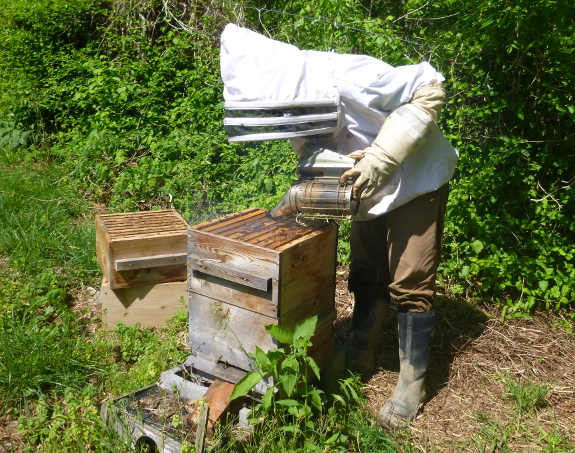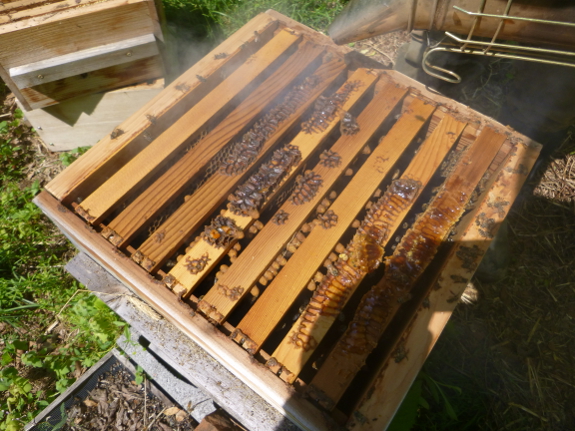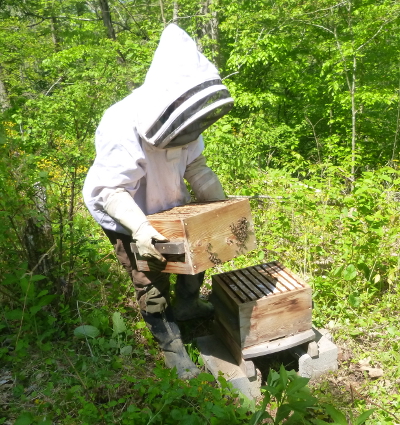
Splitting the Warre hive

At this time last year, the bees in our Warre hive swarmed. Even though I have several swarm traps out this year, I know that catching a swarm is a gamble, so I decided to go against the Warre party line and preemptively split our hive.

The last time I split a hive,
I was using Langstroth boxes and didn't realize how intrusive all of my
poking around inside the colony was. So, at that time, I went through and made sure both new hives had frames of eggs, capped brood, and honey.
I didn't want to be so disruptive this time around, especially since our
Warre hive frames are technically movable but actually tend to tear
comb when removed. So this year's split is more of a gamble --- I
don't know for sure that both hives have the eggs  necessary
to make a new queen. If I'm unlucky and the queen and eggs are
all in one colony, I'll either buy a queen for the other colony or will
just put the two hives back together. (As a side note, I think
that's capped drone brood in the photo above, not queen cells --- what
do you think?)
necessary
to make a new queen. If I'm unlucky and the queen and eggs are
all in one colony, I'll either buy a queen for the other colony or will
just put the two hives back together. (As a side note, I think
that's capped drone brood in the photo above, not queen cells --- what
do you think?)
Even without poking
through the frames, though, I can make sure that both hives have an
equal chance of success. With a split, the hive that you leave in
the old location gets an automatic boost since all of the worker bees
out foraging will go home to that location. So I took the heavier
box to the new spot (in the starplate pasture), figuring the lack of
workers there would mean the daughter hive could use the extra
honey. I'll also start feeding both hives, even though there are
lots of flowers in bloom, since a split is definitely a setback for each
set of bees.
Splitting the hive means
that, once again, we probably won't get honey this year. However,
the colony I split has proven its worth as a survivor colony despite not
being treated with any chemicals. Maybe, if I'm lucky, both
daughter hives will survive and thrive and give us honey in 2015.
Want more in-depth information? Browse through our books.
Or explore more posts by date or by subject.
About us: Anna Hess and Mark Hamilton spent over a decade living self-sufficiently in the mountains of Virginia before moving north to start over from scratch in the foothills of Ohio. They've experimented with permaculture, no-till gardening, trailersteading, home-based microbusinesses and much more, writing about their adventures in both blogs and books.
Want to be notified when new comments are posted on this page? Click on the RSS button after you add a comment to subscribe to the comment feed, or simply check the box beside "email replies to me" while writing your comment.

I have heard that when you move a hive, it has to be either less than two meters or more than two kilometers. The bees will navigate by their memories. If it is all new to them, (far away) they will come back to the new location, but if it is near the same regular foraging area, they will return to the old hive.
I don't know if this is true or not, just what I have heard.
Anonymous --- That's what I figured. Everything seems to look different in a Warre hive, I think because I peek down between the frames rather than taking them out to look head-on.
Eric --- That's definitely true if you move a hive. However, splitting a hive is a different matter because bees won't leave brood behind. All of the workers bees who are in foraging mode will go back to the old hive location, but all of the nurse bees will stay in the new hive to tend the brood, and as new bees hatch, they'll home in on the new location. That's why I gave the bees in the new location more honey --- they won't have any foragers for a while. But they will have nurse bees and, hopefully, eventually a queen and new foragers.